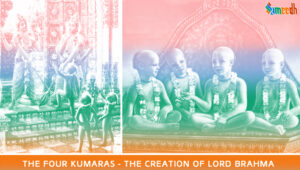Sanatkumar, one of the four Kumars (Sanaka, Sanandana, Sanatana, and Sanatkumar) who are renowned sages in Hindu mythology. The Sanatkumar Samhita is a part of the larger collection of texts known as the Shiv Puran. The Shiv Puran is one of the eighteen Mahapurans, a genre of ancient Hindu texts that cover a wide range of topics including mythology, cosmology, philosophy, and the worship of various deities.

The Sanatkumar Samhita is dedicated to Sanatkumar, one of the four Kumars (Sanaka, Sanandana, Sanatana, and Sanatkumar) who are renowned sages in Hindu mythology. This particular section of the Shiv Puran, one the Mahapurans focuses on the teachings and conversations between Lord Shiv and the sage Sanatkumar.
Sanatkumar, also known as Sanatkumara, is a revered sage in Hindu mythology. He is one of the four Kumaras, who are believed to be the mind-born sons of the creator god Brahma. The other three Kumaras are Sanaka, Sanandana, and Sanatana. Sanatkumar is often depicted as eternally youthful and possessing great wisdom.
Here are some key aspects and stories associated with Sanatkumar:
- Renunciation and Wisdom: Sanatkumar is renowned for his unwavering commitment to spiritual life and renunciation of worldly attachments. He is depicted as a sage who embodies profound wisdom and spiritual knowledge.
- Teacher of Dhruv: One of the significant stories involving Sanatkumar is his encounter with Dhruv, a young prince who sought to attain a higher status than his stepbrother. Sanatkumar appeared before Dhruv during his penance and imparted spiritual teachings to him, guiding him on the path of devotion and enlightenment. Dhruva followed Sanatkumar’s teachings and eventually attained his goal, becoming the pole star (Dhruv Nakshatra) and achieving great spiritual realization.
- Role in Creation Myth: In some versions of Hindu mythology, Sanatkumar plays a role in the creation myth. He is said to have been present at the beginning of creation and is often associated with the preservation and transmission of cosmic knowledge.
- Friend of Narad Muni: Sanatkumar is often depicted as a close friend and companion of Narad Muni, another revered sage in Hindu mythology. Together, they engage in spiritual discussions and journeys across the cosmos.
- Guardian of Knowledge: Sanatkumar is considered a guardian of sacred knowledge and is often consulted by gods, sages, and seekers for his wisdom and guidance on matters of spirituality and philosophy.
Sanatkumar’s character symbolizes the pursuit of wisdom, renunciation, and spiritual enlightenment in Hindu tradition. His teachings and encounters with other figures in mythology serve as valuable lessons on the path of devotion, knowledge, and transcendence.
Key themes and topics covered in the Sanatkumara Samhita include:
- Cosmology: Like many other Puranic texts, the Sanatkumar Samhita elaborates on the creation and dissolution of the universe, the structure of the cosmos, and the various realms of existence.
- Spiritual Knowledge and Philosophy: The text delves into profound philosophical discussions between Lord Shiv and Sanatkumar, exploring topics such as the nature of reality, the essence of the self (atman), the paths of spiritual liberation (moksh), and the principles of dharm (righteousness).
- The Worship of Shiv: Being a part of the Shiv Puran, the Sanatkumar Samhita also contains descriptions of various rituals, prayers, and hymns dedicated to Lord Shiv, as well as the significance of his worship for spiritual seekers.
- Mythological Narratives: The text includes mythological stories and legends related to Lord Shiv, his consort Parvati, and other divine beings, illustrating their roles in the cosmic order and their interactions with humanity.
- Ethical and Moral Teachings: Alongside its philosophical and mythological content, the Sanatkumar Samhita imparts moral and ethical teachings, guiding readers on virtuous conduct, righteous living, and the pursuit of spiritual growth.
The Sanatkumar Samhita, like other sections of the Shiv Puran, serves as a repository of spiritual wisdom, providing guidance and inspiration for devotees on their spiritual journey and fostering a deeper understanding of the divine mysteries of existence.
